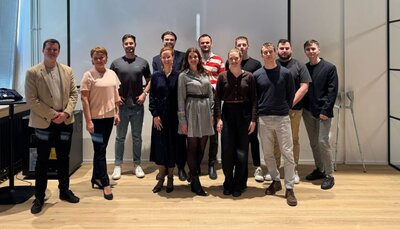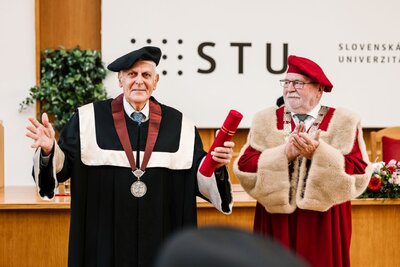BRATISLAVA 12. October 2015 – The new Centre for Nano-diagnostics disposes of devices which are unique with the V4 region. They enable to study the structure of materials at the atomic level.
The Centre was opened by the Slovak University of Technology as part of the University Science Park Project entitled “Science City Bratislava“.
The new equipment at the Centre for Nano-diagnostics allows scientists to study objects million times smaller than a human hair. Dimensions of tens of nanometres can be observed.
No other laboratory in Slovakia has atomic resolution analytical transmission electron microscope with such parameters. Thanks to additional equipment and special attachments this unit is unmatched by any other V4 country. The main advantage of the device, in addition to the extremely high resolution, is a combination of top-class complementing devices. The device allows detecting not only the physical layout of atoms with a detection limit of 0.07 nm, but also the crystallographic arrangement of atoms by integrated diffraction methods, and their chemical bonds using spectroscopy.
Detailed chemical composition can be determined also by the Auger Electron Spectroscopy, also unique in Slovakia. Both devices complement each other; they enable close analysis of each nanoparticle and define its properties which may determine further research and/or industrial application.
"Nanotechnologies are now a key scientific discipline. The number of applications in various industrial sectors across the world has increased, e.g. in cosmetics, pharmaceuticals, in waterproof/abrasion resistant clothing or clothing with antibacterial properties, in windows cleaning preparations which are due to nanoparticles resistant to frost and fog.
There are also prospective materials for microelectronics and green energy. To develop these new materials we need to know their structure, chemical composition at the atomic level and their interaction with living organisms", said Mária Čaplovičová from the Centre for Nano-diagnostics.
The Centre scientists are already working on research sensors to detect chemicals, including pollution in the air or water. Sensors with nano-structured coatings can detect contamination at very low concentrations which the current equipment cannot.
The Centre does not however serve just the STU scientists. The intention is to co-operate with other scientific teams at universities and the Slovak Academy of Sciences, and also with companies that carry R&D in nanotechnology. The work of teams dealing with nanotechnologies can be in fact facilitated by the analysis of samples at the Centre.
The Centre for Nano-diagnostics at STU was established as part of the University Science Park project “Science City Bratislava” which has also helped to renovate and modernise various university buildings and laboratories, and creates centres for scientific excellence.
"New scientific instruments are a prerequisite for cutting-edge research, particularly in the field of advanced materials. Thanks to its equipment and instrumentation the Center for Nano-diagnostics is ranked among the top base workplaces worldwide for transmission electron microscopy. We have already been approached to organize the first meeting of users of similar facilities from around the world. The position of the Slovak Technical University, but principally Slovak scientists has been greatly improved in the international scientific community", said Robert Redhammer, Rector of STU.
"The top quality equipment is however not enough to secure top results. The equipment must be placed in an environment with no vibration or electromagnetic interference. I am proud of the work of our fellow engineers who managed to create ideal conditions for the sensitive equipment. I am also proud of fellow scientists who have already in the first days of work in the new facilities made new scientific observations. They deserve our respect and admiration", he added.
Other new laboratories which have been gradually set up at STU include: Research Centre for Computer Technologies and the Internet, Research Centre for User Experience and Interaction, Research Centre focused on electronics, organic electronics & photonics and Data & Cloud Centre. In other areas of research the University has established the Biocatalysis Centre, Centre for the development of new composite materials and biomaterials, Product Design Laboratory, e-mobility Laboratory and laboratories focused on low-energy construction, environmental quality of buildings and development of new advanced building materials.
In addition to the Bratislava based University Science Park another one has been built on the Trnava campus. The Park in Trnava focuses on material research, ion and plasma technologies, automation and innovative 5-axis production processes. Each park received a total investment of EUR 42 million; EUR 35.7 million was received from EU funds (Operational Programme for Research and Development) and the remainder from the government and STU budgets.
 |
 |
 |
 |
 |
 |
 |
 |
 |
 |
 |
 |
Media contact:
Andrea Settey Hajdúchová, Communications Manager, Slovak University of Technology
andrea.hajduchova@stuba.sk +421 917 669 205 www.stuba.sk
The Slovak University of Technology in Bratislava (STU) is a modern research and higher education institution. In the Times Higher Education World University Rankings it is listed in 601.-800. place. According to the Slovak higher education ranking scheme carried out by ARRA, STU is the best university in chemicals technologies, computer and technical sciences. Each year 16 000 regular and 4 000 lifelong learning students attend its 7 faculties. Education is based on own scientific research and focused on industry needs. In 2014 STU’s researchers participated in 274 research contracts with industry partners and in almost 500 research projects funded through grants. STU graduates are some of the most successful and the highest paid employees on the Slovak job market.



